#30J Roundup: Bullets over ballots
The election was fake, but the violence was real: a detailed look at the mayhem nationwide as Venezuelans reject the government’s attempt to institutionalize dictatorship.


A day of mayhem nationwide, as the government’s fraudulent Constituent Assembly elections are overshadowed by fierce repression and violence against protesters. As of 8:15 p.m. at least 14 people have died — by far the bloodiest of any day since the beginning of the protest cycle almost 4 months ago.
It was a day of carnage.
The Venezuelan Observatory of Social Conflict reported several protests across 18 of the country’s 24 states: repression day, more than election day.
The Prosecutor’s Office is investigating the five following murders, all of them by firearm:
Eduardo Olave, 39. Libertador, Mérida.
Angelo Méndez, 28. Libertador, Mérida.
Luisa Zambrano, 43. Barquisimeto, Lara.
Ricardo Campos, 30. Cumaná, Sucre.
GNB officer Ronald Ramírez Rosales. La Grita, Táchira.
Two other murders are being investigated by the Ministerio Público, although it has not confirmed the names, presumably because they are underage,
Luis Ortiz, 16. Tucapé, Táchira
Adrián Rodríguez, 13. Capacho Viejo, Táchira.
The following five murders, also by firearms, are yet to be acknowledged by the Prosecutor’s Office:
Iraldo Gutiérrez, 38. Chiguará, Mérida.
Albert Rosales, 53. Tucapé, Táchira.
Wilmer Smith Flores, 21. La Grita, Táchira.
Juan José Monjes, 42. Aguada Grande, Lara.
Julio Manrique, 22. Ureña, Táchira.
Today’s sham election began with none other than early riser Nicolás Maduro, casting his ballot amid little fanfare, ostensibly to avoid another egg-throwing debacle. Social media lit up after State TV showed his carnet de la patria being rejected by a smartphone (an illegal Carnet de la Patria identification station was added outside some voting centers in an effort to intimidate voters). In a serendipitous bit of poetic justice the device read that the “person doesn’t exist” or the “id was annulled.” Venezuelan hacker YoSoyJustin_ claimed responsibility for the snafu.
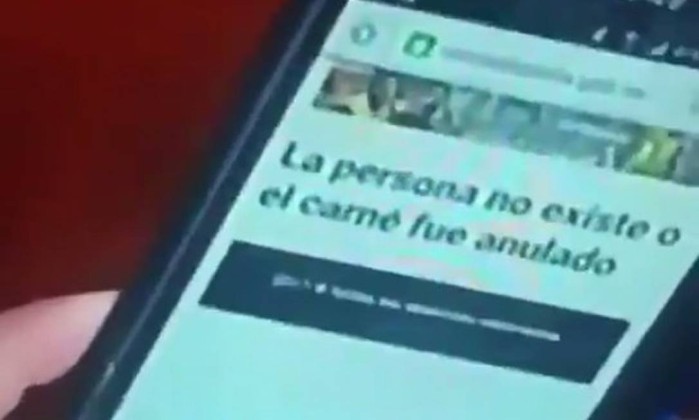 Early in the morning, National Guard officers took over the Francisco Fajardo highway to prevent protesters from gathering there. Later, GNB troops chased protesters firing rubber bullets and tear gas. In a still murky incident an explosive device was set off in Avenida Francisco de Miranda in front of Plaza Altamira setting ablaze several GNB motorcycles. Seven GNB officers were wounded by the explosion, and four motorcycles destroyed.
Early in the morning, National Guard officers took over the Francisco Fajardo highway to prevent protesters from gathering there. Later, GNB troops chased protesters firing rubber bullets and tear gas. In a still murky incident an explosive device was set off in Avenida Francisco de Miranda in front of Plaza Altamira setting ablaze several GNB motorcycles. Seven GNB officers were wounded by the explosion, and four motorcycles destroyed.
At 2:50 p.m., journalist Víctor Amaya reported that there were no voters left at the large voting center set up at the Poliedro de Caracas. Jorge Roig, former head of Fedecámaras, explained that if the 100 voting tables installed in the Poliedro had one voter every 20 seconds, only 140,000 people would be able to vote there in eight hours.
According to Luis Pedro España, the high profile Catholic University academic, the latest turnout estimate ranged between 2.5 and 2.8 million, quipping that: “any figure the CNE announces will be the last in its history.”
Midday, National Assembly Speaker Julio Borges said that the CNE had already put together a report to announce that 8.5 million people voted, but the actual figure would be closer to 7% of the electoral registry: around 3 million voters.
“It’s rare for a country to have such clear evidence of an electoral fraud,” Borges said. “With the ANC, they’re accelerating their own downfall, digging their own grave.”
According to journalist Javier Ignacio Mayorca: “the military hasn’t voted either.” Nonetheless, Héctor Rodríguez claimed that today’s would be “one of the highest turnouts in Venezuela’s electoral history.”
Instead of urging people to vote, the PSUV kept noting how the carnet de la patria will allow them to know who voted and who didn’t. They chose coercion despite (or because of) enormous levels of abstentions.
Mayor Jorge Rodríguez broke his own record for pathetic lies. After saying that “a guy voted 17 times” at the do-it-yourself referendum on July 16th, today he said that there were voters from eastern Caracas who rode to the Poliedro on their bicycles. Rodríguez laughed —literlly laughed— when asked about the deaths that have taken place throughout the day, even though they’ve widely reported by major media outlets and confirmed by the Prosecutor General’s Office.
#Video Con una sonrisa Jorge Rodríguez negó muertes durante elección #Constituyente https://t.co/7Uwp1BSKLc pic.twitter.com/2QebgvRQ87
— CaraotaDigital (@CaraotaDigital) July 30, 2017
Sick.
Incidents in Caracas
#ENVivo Cerrados los accesos a la autopista Francisco Fajardo en el Distribuidor Altamira por efectivos de la GNB #30Jul pic.twitter.com/AgJid1ny4j
— El Nacional (@ElNacionalWeb) July 30, 2017
#30Jul 11:35am PNB y GNB barrió con manifestantes en la plaza Altamira tras emboscada con perdigones y lacrimógenas pic.twitter.com/HxHDvv2Bl3
— Raylí Luján (@RayliLujan) July 30, 2017
Siete funcionarios de la Policía Nacional resultaron heridos tras explosión en Altamira https://t.co/ar0visLvms pic.twitter.com/oomhm3mgL7
— NTN24 Venezuela (@NTN24ve) July 30, 2017
Colectivo members, with the support of GNB officers, attacked protesters in the Bello Campo neighborhood, stole and burned motorcycles, including one belonging to a NY Times reporter.
Paramilitares armados arremeten en Bello Campo: Queman y roban motos (Fotos) https://t.co/UaCNFWGHgW
— La Patilla (@la_patilla) July 30, 2017
In a confusing incident, DGCIM officers (military counterintelligence) and GNB officers apparently engaged in a friendly fire incident in Chacao,
Operadores especiales y militares se cayeron a tiros entre ellos en Chacao. División Asuntos Especiales DGCIM en el sitio (Foto: @Sincepto) pic.twitter.com/TjOcTGTohM
— Daniel Blanco (@DanielBlancoPaz) July 30, 2017
National Guard Anti-Kidnapping Unit (CONAS) officers repressed protesters in the western Caracas neighborhood of el Paraíso with tear gas and rubber bullet. However, neighbors vigorously fought back and at a point successfully made the GNB tanquetas to back down.
#30Jul Manifestantes de la Cota 905 hicieron retroceder a dos tanquetas del Conas. Reportó: @GerardoEnrique4 https://t.co/CSYYDLNHFB pic.twitter.com/XmeSqiUDFv
— CaraotaDigital (@CaraotaDigital) July 30, 2017
There were also clashes between protesters and GNB officers in Santa Fe where the officers unsuccessfully tried to disperse the protesters gathering there:
#30J La gente no se mueve de la autopista Prados del Este, distribuidor Santa Fe. Algunos juegan con una pelota de goma #Caracas pic.twitter.com/LJLHP9APNs
— Andreína González (@InaGonzalezO) July 30, 2017
Mérida
The situation in Merida had been tense even before election day. Riots yesterday left two dead: Marcel Pereira and Iraldo Gutiérrez, both of gunshots.
Today, at around 7:00 am, two protesters supposedly attempting to take a voting center in San Jacinto, a traditionally chavista sector of the city, were shot dead by members of Plan Republica who allegedly left the scene shortly afterwards.
The victims were identified as Eduardo Olave and Angelo Méndez. At the same time, GNB tanquetas (armored personnel carriers) did their best to clear main roads that have been blocked by barricades since Thursday, breaching the gates of some residential buildings in the process.
Tanquetas de la GNB y tractor tratan de tumbar barricadas en avda Centenario de#Ejido..#Mérida.#30Jul pic.twitter.com/FpCYzNWnOC
— Leonardo León (@leoperiodista) July 30, 2017
Enlace estadio Metropolitano de #Mérida..#30jul pic.twitter.com/0a4oEmmw6H
— Leonardo León (@leoperiodista) July 30, 2017
Nos estan atacando en Sta Barbara @elsapito_ula @AnonymousVene10 pic.twitter.com/0U09Ng3qfM
— Mithrandir (@JuanMaPaez) July 30, 2017
Vecinos rcias El Molino en #Ejido reportan que ingresaron 3 tanquetas y derribaron portón y estan siendo atacados.#Mérida.1:45pm pic.twitter.com/ppAolRmS6B
— Leonardo León (@leoperiodista) July 30, 2017
Most election centers looked empty, just like streets around the city. Chavismo however managed to gather a few people, concentrating voters in two of the city’s biggest centers, Libertador High School and Mucumbarila Convention Center.
Calles del centro de #Mérida #30jul pic.twitter.com/svyGh1koVW
— Leonardo León (@leoperiodista) July 30, 2017
Centro de convenciones Mucumbari.#Mérida #30 jul. pic.twitter.com/dXVJaFpEJD
— Leonardo León (@leoperiodista) July 30, 2017
Liceo Libertador #Mérida. #30Jul .8am pic.twitter.com/3Hj27l4rad
— Leonardo León (@leoperiodista) July 30, 2017
The local airport, which has been closed to commercial traffic for several years, had never seen so much activity as this weekend. Military Hercules C-130 planes have been spotted landing in Mérida since yesterday carrying military personnel and equipment. A number of colectivo (paramilitary) groups have been patrolling the city, using both public, State-sponsored buses and unidentified trucks to get around.
#30J Uso evidente del bien público @TROMERCA para colaborar con paramilitarismo en #Mérida configurándose como terrorismo de Estado #DDHH pic.twitter.com/w3tOm4OlpZ
— PROMEDEHUM (@promedehum) July 30, 2017
Civiles y efectivos armados vigilan desde Complejo Deportivo 5 Águilas a manifestantes de Campo Claro #Merida #30Jul 2:30pm pic.twitter.com/yM4joOIypf
— 𝓨𝓪𝓷𝓪𝓻𝓪 𝓥𝓲𝓿𝓪𝓼🎙️ (@YanaraVivas) July 30, 2017
Ayer llegó a Mérida avión cargado de funcionarios, resultado hasta ahora: 5 asesinatos. Acaba de llegar otro. Seguirán masacrando al pueblo? pic.twitter.com/zyAQVwOlEk
— Carlos García (@CarlosGarc1a) July 30, 2017
In the early afternoon reports of heavy riots in Ejido —a city 5 km. west of Mérida— started flooding social networks as Mayor Omar Lares’ house was seized by state security forces. Lares managed to escape but his son was captured.
Atención: Intentan detener Alcalde de #Ejido Omar Lares.Funcionarios de civil rodearon su vivienda #Mérida #30jul..3pm
— Leonardo León (@leoperiodista) July 30, 2017
Los delincuentes que intentaron detener al alcalde @omarlaress se llevaron a su hijo Juan Lares y en este momento sacan cosas de su casa pic.twitter.com/Yc4INzzKmY
— Carlos García (@CarlosGarc1a) July 30, 2017
At the same time, police and GNB officers breached an apartment building, smashing through the gates, burning some vehicles and taking an unknown number of people into custody.
Tanquetas de la GNB destruueron portón de rcias El Molino en #Ejido..#30Jul pic.twitter.com/WPjWymaIhJ
— Leonardo León (@leoperiodista) July 30, 2017
Queman motos en rcias El Molino de #Ejido..#Mérida.#30jul..2:15pm pic.twitter.com/e25fiS4QVv
— Leonardo León (@leoperiodista) July 30, 2017
Se desconoce número y paradero de los detenidos en rcias El Molino y Centenario de Ejido..#Mérida #30jul pic.twitter.com/FnsNNXLk8k
— Leonardo León (@leoperiodista) July 30, 2017
The situation in Tovar, a nearby small town, has also been tense. Since the early morning small groups of voters were escorted by GNB officers to the few voting center that remained operational after yesterday’s riots. Confrontations took place shortly after and reports of several wounded protesters started to appear. The conflict quickly turned so heavy that local priests tried to mediate with state security forces, leaving us one of the most touching pictures of the current protest cycle so far.
Sacerdotes de #Tovar tratan de mediar para tratar de contener la represión. Hay heridos graves..#Mérida #30jul.. pic.twitter.com/69FDhdFCfw
— Leonardo León (@leoperiodista) July 30, 2017
Several protesters were wounded by live ammo, and a local first aid team was assaulted by official forces as denounced by Merida’s Mayor Carlos García.
En Tovar la represión es desmedida y brutal, nos reportan varios heridos de bala, en Mérida estamos viviendo una masacre! pic.twitter.com/JK0QxyOpTS
— Carlos García (@CarlosGarc1a) July 30, 2017
Ni en las más cruentas guerras se ven éstas acciones. Solidarios con todo ese gran voluntariado que arriesga su vida para salvar la de otros https://t.co/ZAssMnvyN1
— Carlos García (@CarlosGarc1a) July 30, 2017
Se mantienen enfrentamientos en #Tovar ..#Mérida..2pm pic.twitter.com/ji6utaWsI0
— Leonardo León (@leoperiodista) July 30, 2017
At 11 a.m. a 19 year-old man was shot dead in unclear circumstances, supposedly while trying to cross a barricade, marking the fifth casualty in the State in the last 24 hours.
Atención: confirman asesinato de manifestante(19) en protestas en #Tovar..Según fue herido con arma de fuego..#Mérida #30jul..11am pic.twitter.com/h9IqoREvwN
— Leonardo León (@leoperiodista) July 30, 2017
People report the presence of snipers around several buildings in town, but this information hasn’t been independently confirmed.
Today has been the most violent day in the State so far, and the night hasn’t even started yet.
Táchira
In the days ahead of the so-called election, violence escalated in Táchira: the Andean state known for the kindness of its people and the ferocity of its resistance to chavismo. Last Friday two men were killed: Eduardo Rodríguez (53) and Gustavo Leal Vilamizar (18), both shot down while protesting. Yesterday, Wilmer Smith Flores (21) was shot and killed during a riot on the city of La Grita.
Today’s picture is even worse. As we write this, the death toll stands at six. The small town of Tucapé saw violence first, as Luis Ortiz (15) got shot by local colectivos. Her mother was notified while attending the morning mass, GNB and armed encapuchados started shooting as soon as they reached the barricade he was manning. The other victim, Albert Rosales (53), was peeking through his balcony trying to find out what was going on when a stray bullet took his life.
Later, a GNB officer, Ronald Ramirez Rosales was shot in the face during a riot in La Grita’s military school Liceo Jauregui. And a few moments later Adrian Romero (14), was shot in the head by a sniper while protesting in the town of Capacho Viejo.
Riots in the border town of Ureña also left a toll of four wounded (including a ten year old), and another death: Julio Manrique (22). The wounded were taken to Cúcuta, Colombia for medical attention.
Gilbert Peña(19) was also shot this afternoon in Rotaría avenue in San Cristóbal, there are conflicting reports of his status. The casualties in the last 72 hours total 8. The number of people wounded is striking: In Tucapé about 40 people were hurt and reports claim there are over 400 all over Táchira.
#30J #Tachira CapachoNuevo varios heridos por arma fuego uno es el concejal Jose Marti, informacion tiros de FAL el ejercito empieza atacar.
— Franklyn Duarte (@FranklynDuarte_) July 30, 2017
GNB ataca a residentes de La Machirí, parte baja, con lacrimógenas y perdigones. #TACHIRA@ReporteYa
Fotos @TorresKatha pic.twitter.com/XagkGCqOiK— Blanca Rodríguez (@BlancaR_Vzla) July 30, 2017
#30deJulio #Tachira #SanCristobal Barrio Romulo Colmenares, Av Rotaría #HaceMinutos @lorearraiz pic.twitter.com/YGcE4JL8E2
— Iralmi Marin (@IralmiMarin) July 30, 2017
https://twitter.com/theajza/status/891764152380928000
En Barrio El Carmen civiles armados recorrieron las calles aterrorizando a los vecinos. #TACHIRA #30Jul@ReporteYa pic.twitter.com/tTILGBMb6L
— Blanca Rodríguez (@BlancaR_Vzla) July 30, 2017
Reports of violence in the hands of colectivos, GNB and the Army come from pretty much every corner of the state. From border cities like San Antonio and Ureña, to Táchira’s capital San Cristóbal. There are reports of army snipers placed in several locations:
#AHORA denuncian presencia de francotiradores en Táchira #jul30 @javiertarazona pic.twitter.com/9k2UCIEPhW
— Elyangelica González (@ElyangelicaNews) July 30, 2017
Adrián Rodríguez (13) fue asesinado en Capacho, Táchira. Francotirador del Ejército le disparó en la cabeza desde la azotea de una escuela.
— Daniel Blanco (@DanielBlancoPaz) July 30, 2017
#URGENTE Reportan asedio a barrio El Diamante en Táriba, estado Táchira este #30Jul https://t.co/3w4M88FOBg pic.twitter.com/R6hHwBMwHM
— NTN24 Venezuela (@NTN24ve) July 30, 2017
The city has been under siege since last week’s paro cívico, with continuous barricades and protests. However, some people still made it to the polls in what the government calls “Elections for Peace.”
Ciudad Guayana
No fatalities have been reported from Ciudad Guayana, but there have been clashes between armed paramilitary groups working with the National Guard and protesters, that have left several with gunshot wounds.
At 5:30 a.m. in Alta Vista, a drive-by shooting hit four protesters blocking a street. Shortly thereafter, the repression came from the GNB. One protester was shot.
In Villa Betania, a housing development, there were other two gunshot wounds.
#Guayana #30Jul En el sector de Villa Betania hubo dos heridos por arma de fuego. En un camión quedaron los orificios de bala. pic.twitter.com/4SMGMeqTft
— Pableysa Ostos (@PableOstos) July 30, 2017
1. GN reprimió en Villa Betania: Cascadas de Betania y El Encanto. Vecinos denunciaron uso de armas de fuego #30Julio #CiudadGuayana pic.twitter.com/BXmkY0kmgT
— Germán Dam (@GEDV86) July 30, 2017
At Isla Dorada, near Villa Betania, repression continues and tear gas canisters have been shot into the residential complex.
Comparen ustedes las fotos de Isla Dorada, tomadas durante y después de la represión, y saquen sus conclusiones #30Julio #CiudadGuayana pic.twitter.com/Iaqmgh1eqM
— Germán Dam (@GEDV86) July 30, 2017
En Isla Dorada 7 bombas fueron lanzadas por la GN contra una vivienda #30Julio #CiudadGuayana pic.twitter.com/7wNRUmpiUH
— Germán Dam (@GEDV86) July 30, 2017
https://twitter.com/trafficGUAYANA/status/891741677789913088
Other barricades hotspots like Lomas del Caroní and Las Garzas have had visits from the GNB. In Las Lomas, the guardsmen burned down the security booth for a second time.
#Guayana #30Jul 3:10 pm / Denuncian los vecinos de Lomas del Caroní que nuevamente funcionarios d ela GNB quemaron garita de vigilancia. pic.twitter.com/hE6O7DZFGd
— Pableysa Ostos (@PableOstos) July 30, 2017
Aragua
Repression started at around 3:00 a.m. in Maracay, with the GNB launching tear gas and breaking barricades around residential areas that have become focal points of protest recently.
Besides the Base Aragua and Residencias del Centro neighborhoods, now Residencias Independencia, located in downtown Maracay and just a few blocks from the Primero Justicia and the Acción Democrática headquarters, have seen repression: two APCs broke into the apartment complex gates.
#29Jul Imágenes de Av Ayacucho frente a Res.Independencia #Maracay pic.twitter.com/Vnu1vjiKs6
— Amira Muci (@amiramucic) July 30, 2017
#30Jul #GNB derriba otro portón en Res Independencia Av Ayacucho #Maracay Hace una hora. Ahora tensa calma. Vía @etorres13 pic.twitter.com/qDrXw4v6cq
— Amira Muci (@amiramucic) July 30, 2017
At the same time, in the South of the city, the National Guard along with the Aragua State Police broke into into Residencias Madre María:
#3ojul Desde la madrugada #GNB y @POLICIA_ARAGUA atacó a Urb Madre Maria en #Maracay. Incuantificables daños en aptos,vehículos @CronicaUno pic.twitter.com/ozTk2h6A4z
— Gregoria Díaz (@churuguara) July 30, 2017
The election itself has been met with half-empty voting centers, despite Maracay and nearby towns being long regarded as a bastion of chavismo.
ESCUELA REPÚBLICA DE MÉXICO #MARACAY REPORTAN NADA DE VOTANTES. … 12:30PM pic.twitter.com/GSvRtQIBKx
— Carmen E. Pecorelli (@CarmenPecorelli) July 30, 2017
#30jul 2 centros electorales bastiones del chavismo en #Maracay: Esc.Felipe Guevara y 23 de enero. Así lucen fotos @ReyCampins @CronicaUno pic.twitter.com/S7Wo64Umau
— Gregoria Díaz (@churuguara) July 30, 2017
UEN Julio Morales Lara 4197 electores, nucleado el Colegio Decroly, 3916 electores. #MBI #Aragua 4pm #30Jul pic.twitter.com/CQuCTLok2T
— Carla Carrera Ortiz (@Borolaki) July 30, 2017
#30Jul #Turmero #Aragua 4:20pm UE Jose Rafael Revenga, centro de votación más grande del casco de Turmero pic.twitter.com/7N2W4pPVQS
— Haissen Barrios (@Haissenb) July 30, 2017
A tense calm remains as GNB breaks any sign of protest and keeps strategic positions around the city:
#30Jul Continúan enfrentamientos entre manifestantes de #BaseAragua y #PNB #Maracay @CronicaUno pic.twitter.com/9lrXcsGDKj
— Gregoria Díaz (@churuguara) July 30, 2017
Así se observa #BASEARAGUA la tarde de este 30/07 pic.twitter.com/ROsDl4bOK3
— Carmen E. Pecorelli (@CarmenPecorelli) July 30, 2017
#MásTemprano Grupos parapoliciales acompañan a la GNB en la represión de la Urb El Centro #30Jul #Aragua pic.twitter.com/LvIhsrmcFQ
— Eleazar Urbaez (@FEDGLOCK) July 30, 2017
Elsewhere in San Casimiro, in the southern part of the state, it was reported that AN deputy Simón Calzadilla’s family was being held by either law enforcement agents or armed forces personnel:
Nicolás te exijo la liberación inmediata de mi esposa y mis hijas, detenidas arbitrariamente por militares del plan república.
— Simón Calzadilla (@simoncalzadilla) July 30, 2017
#30Jul Rechazamos cobarde detención de esposa e hijas menores de edad de Dip @simoncalzadilla en #SanCasimiro #Aragua por parte de GNB
— Mariela Magallanes (@MariMagallanesC) July 30, 2017
MUD confirma que esposa e hijas menores de edad del diputado Simón Calzadilla fueron detenidas por el Sebin 5:17PM #30J
— Víctor Amaya (@victoramaya) July 30, 2017
Carabobo
Things were relatively calm in Valencia, with protesters setting up barricades in nearby San Diego to keep Plan República personnel from getting around:
#30Julio Vecinos trancaron la avenida Don Julio Centeno del Mun. San Diego, en #Carabobo, en protesta en contra de la Constituyente. pic.twitter.com/UpRmXJ1ond
— CaraotaDigital (@CaraotaDigital) July 30, 2017
https://twitter.com/AndrewsAbreu/status/890279799809298432
Valencia proper had its turn later in the afternoon:
https://twitter.com/AndrewsAbreu/status/891758639710711808
But, unsurprisingly, the voting centers around Carabobo’s capital city were mostly deserted:
UE Regino Peña, reportedly the largest voting center in the Valencia area:
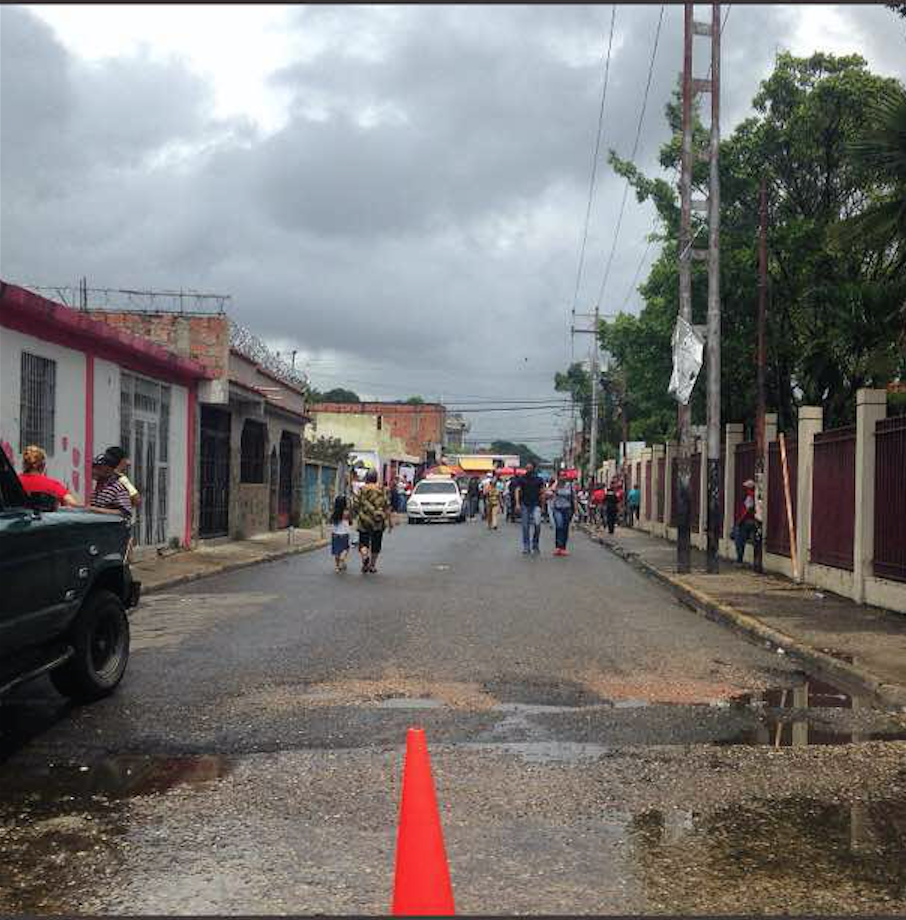 CLAP checkpoint for voters at Las Palmitas:
CLAP checkpoint for voters at Las Palmitas:
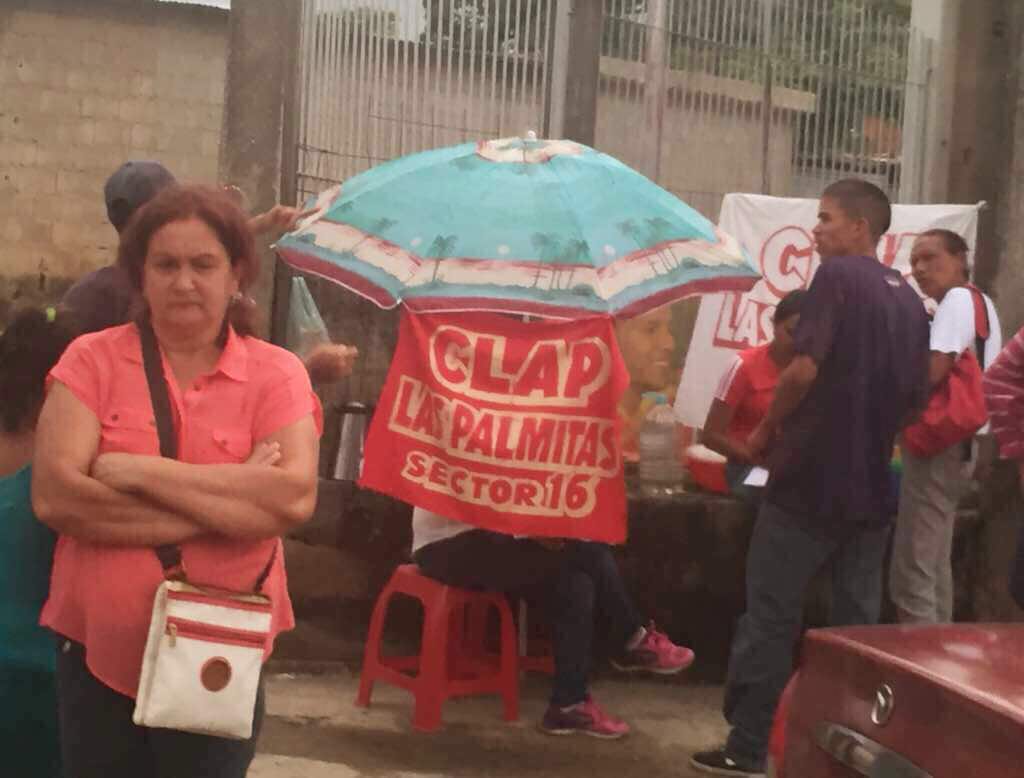
Escuela 19 de Abril at one of the most populated districts of Valencia:
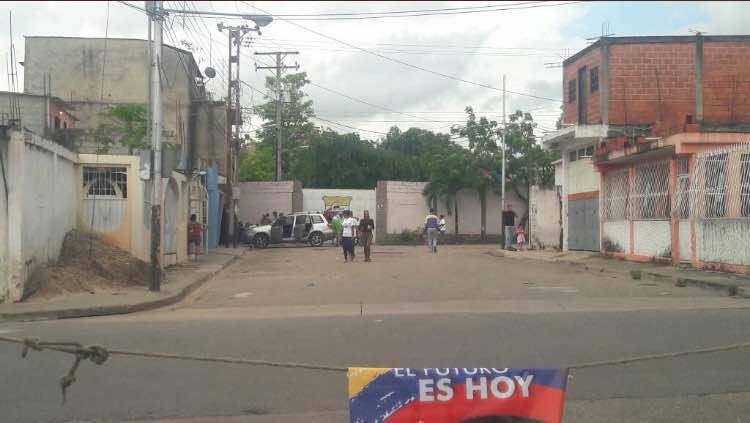
A scant morning crowd waits outside UE Caribay, Lomas de Funval:
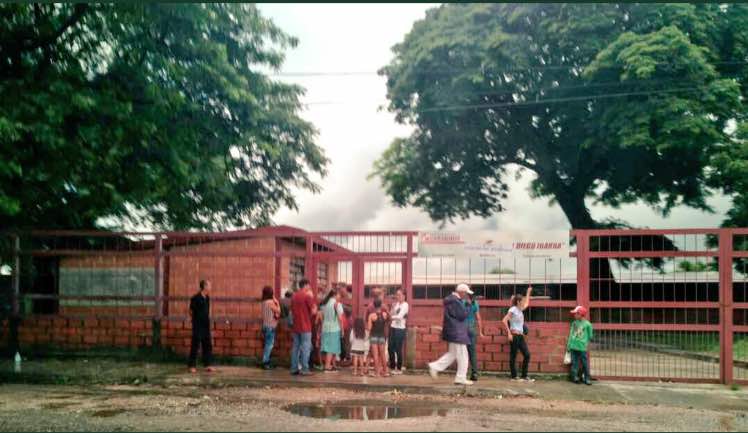 As we wait for Tibisay to announce “results” of a fraudulent election with no auditable voter rolls, with no international observers, in which journalists were barred from within 500mts. of voting centers, and where government workers were coerced and blackmailed into turning out, let’s remember the number of votes eventually, whether true or false, is irrelevant. Abstention won the day: there’s no way to refute that. Repression, death and media censorship are out in the open.
As we wait for Tibisay to announce “results” of a fraudulent election with no auditable voter rolls, with no international observers, in which journalists were barred from within 500mts. of voting centers, and where government workers were coerced and blackmailed into turning out, let’s remember the number of votes eventually, whether true or false, is irrelevant. Abstention won the day: there’s no way to refute that. Repression, death and media censorship are out in the open.
Today, nobody cares about the CNE’s announcements, there’s no sense of expectation, only pain. Too many people murdered for the imposition of a man who scarcely boasts a 17% approval rating. This is the constituyente through fire and blood. It’s conquering through bullets what they couldn’t get through votes.
Caracas Chronicles is 100% reader-supported.
We’ve been able to hang on for 22 years in one of the craziest media landscapes in the world. We’ve seen different media outlets in Venezuela (and abroad) closing shop, something we’re looking to avoid at all costs. Your collaboration goes a long way in helping us weather the storm.
Donate




